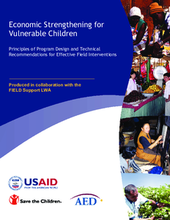The multi-faceted nature of child vulnerability–whether due to such epidemics as HIV/AIDS, conflict, natural disasters, extreme poverty, or a host of other contextual factors–is reflected in the wide spectrum of professional disciplines that have mobilized to address it. Among these, economic strengthening is gaining in importance and prominence, with few experts working to reduce child vulnerability in doubt that poverty is a major contributor to the challenges they face. Unfortunately, very few specialists feel comfortable working at the intersection of these disciplines, which have generally become more technical and specialized and often appear impenetrable to outsiders. So, on the one hand, economic development professionals rarely master the complexity of the political, social, and health issues at stake; on the other, their own efforts to make their discipline accessible to practitioners in other fields have been limited.
This guide begins to fill this gap through the illustration of economic strengthening best practices in a format that multi-sectoral teams of donors and practitioners can use to inform their own work. To that end, the document offers two sets of tools:
1. A series of seven principles for program design and implementation, which donors and partner agencies may refer to as they progress from early program concept through implementation, monitoring, and evaluation. These principles emphasize multi-sectoral coordination, thorough market research, careful consideration of targeting, incorporation of market realities, awareness of the latest technical lessons learned, collaborative partnerships, and focus on scale and sustainability.
2. A set of technical recommendations on how to implement selected economic strengthening activities. These interventions are classified according to three main categories: social assistance, asset growth and protection, and income growth. For each selected intervention within these categories, the guide provides examples from Africa, discusses what works and what does not, and provides recommendations for successful field implementation.
The document also provides an annotated list of technical references and concludes with a glossary of terms. Although initially conceived as a guide to economic strengthening for children affected by HIV/AIDS, the development process made it apparent that these lessons have relevance beyond this context. As such, the guide is valuable for practitioners across a broad range of disciplines and aims to inform practice accordingly.

